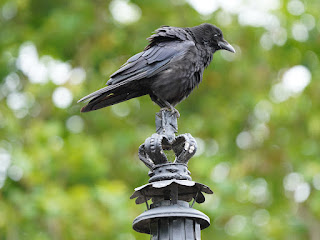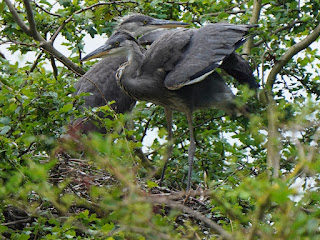It was a drizzly day. A young Pied Wagtail sprinted through the wet grass beside the Round Pond.
Almost all the Pied Wagtails here are young. They must have had a successful breeding year. Although the number of flying insects is very low after the cold spring there are still plenty of midges for them.
The female Little Owl was in her usual place in the lime tree.
The owlet was calling from a horse chestnut, but had gone right into the leaves to keep dry and I couldn't see it.
Ahmet Amerikali saw the female Kestrel over Buck Hill. I think she's permanently in the park, but her hunting ground is the full width of the north side so you don't see her very often.
He also found a young Blackcap near the Henry Moore sculpture, so there has been another breeding success in addition to the family near the Italian Garden.
A female Blackbird in the Flower Walk perched on the railings. Evidently someone has been feeding her, because she waited expectantly until I produced some raisins.
A Jay on a branch was looked sadly tatty. Probably it had lost feathers off its head through feeding young and hadn't regrown them yet.
A young Carrion Crow did its best to shell a peanut. This skill takes a while to learn. An adult can do it in ten seconds, and the smaller Jackdaws Magpies and Jays are almost as quick.
Another crow perched grandly on the little metal crown ornamenting the chimney of a gas lamp post.
We don't see much of Pigeon Eater these days, as he hunts in other places than his original ground where the Feral Pigeons all know and avoid him. But today he was in his favourite place on the roof of the Dell restaurant.
The young Grey Herons on the island are now so tall that then they stand up you can see them from the other side of their nest tree.
A heron on a planter in the Italian Garden shook out its feathers.
Herons use the rails, which are at least 18 inches (45 cm) above the water, as fishing stations. It's astonishing how low they can reach down without losing their balance.
The Great Crested Grebes' nest on the chain at the island is still holding on. I really didn't think it would last, but the sloppy mess seems to be quite enduring as long as the grebes keep adding weed to the top.
The Coots nesting at the bridge, happy at having eggs at last, were busy keeping their nest in good order.
The Coots with one chick on the Long Water were preening on the nesting island. One of the parents tired of this and set off briskly to find something to eat.
The raft on the Long Water, which had been falling to pieces for some time, has gone and today I saw the remains being carried away in one of the park pickup trucks. This is the last picture I have of it, taken the day before yesterday when a lot of Canada Geese came on to the Long Water from the Serpentine.
It was supposed to be a nesting place for terns, but crazily it was never equipped with the small white stones and sheltering place that are necessary to attract terns. When it was newly built I saw a pair of Common Terns flying around it, but they didn't even bother to land and never came back. Now you very seldom see terns on the lake at all, as they have been lured away by several new bird reserves along the river which offer much better breeding sites.
The drizzle didn't stop a hardy Buff-Tailed Bumblebee from gathering pollen on a hydrangea in the Rose Garden.
Two rather tough-looking men were being filmed in a pedalo. I could hear some fragments of conversation and they were saying what good exercise it was -- and indeed it is, because the paddle is so inefficient that you have to pedal like a demon to reach walking speed. This may be the start of a Splash Your Way to Health campaign. On the other hand, it may not.

%202024%201a.jpg)
%202024%201a.jpg)



%20back%20on%20roof%202024%201a.jpg)








Glad you have a female blackbird to feed: I absolutely love the way they flap their wings and cluck to get your attention when they know you have something for them. :)
ReplyDeleteI had a particularly trusting female Blackbird a few years ago. Once she tried to land on my hand but fell off. We agreed not to try that again.
DeleteI love how agile and deft the Coot is to snatch twigs off the water without breaking its stride. Er, swim.
ReplyDeleteThis year has been very good for small birds, hasn't it? It seems to me there are more youngsters than other summers.
Tinúviel
It's been a good year for songbirds, but dreadful for waterfowl. I've never seen so few geese survive.
DeleteGood to see the Kestrel. A bird that seems to have declined considerably. Last month several of us spent 4 days in Pembrokeshire & travelling to & from Swansea Station. We didn't see a single one.
ReplyDeleteRichmond Park seems one of the best places to see them.
There used to be plenty of Kestrels in central London. I think the incoming Peregrines drove them away. Quite likely this Kestrel stays on the north side of the park to avoid the Peregrines on the barracks.
DeleteThere is, or at least recently was, a very bold pair of Kestrels a short distance up the northwest path going uphill from the central causeway of Pen Ponds. They perched in some low trees and were ridiculously easy to photograph at close quarters.
Four Peregrines were flying around Cromwell Road this morning, so I dont know if they have been chased away yet.
ReplyDeleteTheodore
Thanks. I went to look there too, but missed them. It did seem a bit early to chuck them out. Hope they come to the barracks.
Delete